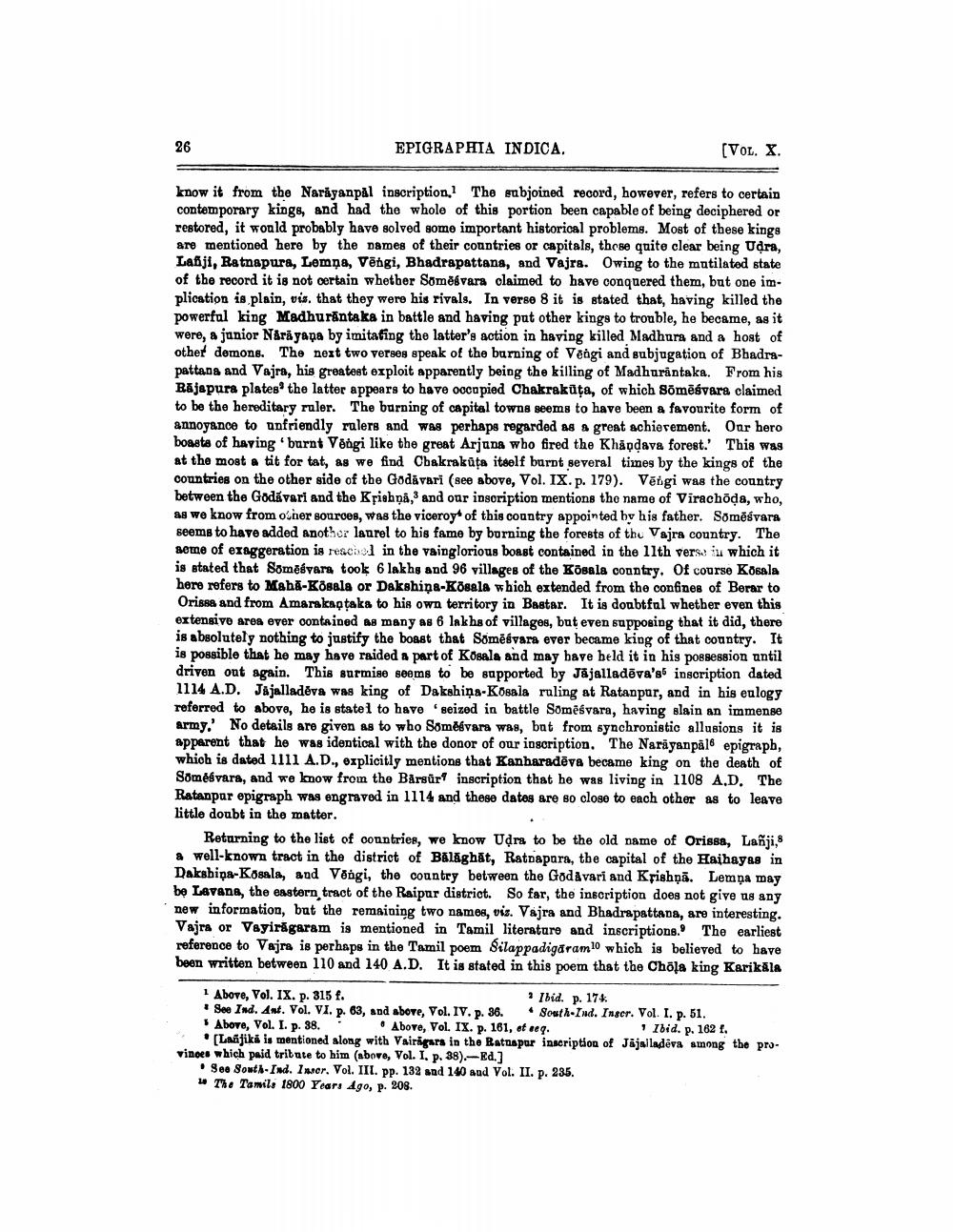________________
26
EPIGRAPHIA INDICA.
(VOL. X.
know it from the Narayanpal inscription. The subjoined record, however, refers to certain contemporary kings, and had the whole of this portion been capable of being deciphered or restored, it would probably have solved some important historical problems. Most of these kings are mentioned here by the names of their countries or capitals, these quite clear being Udra, Lanji, Ratnapura, Lemņa, Vēngi, Bhadrapattana, and Vajra. Owing to the mutilated state of the record it is not certain whether Somē vara claimed to have conquered them, but one im. plication is plain, vis, that they were his rivals. In verse 8 it is stated that, having killed the powerful king Madhurantaka in battle and having put other kings to trouble, he became, as it were, a junior Narayana by imitating the latter's action in having killed Madhurs and a host of other domons. The next two verses speak of the burning of Vengi and subjugation of Bhadrapattaos and Vajra, his greatest exploit apparently being the killing of Madhuråntaka. From his Bajapura plates the latter appears to have occo pied Chakrakūta, of which sömēsvara claimed to be the hereditary ruler. The burning of capital towns seems to have been a favourite form of annoyance to unfriendly rulers and was perhaps regarded as a great achierement. Our hero boasts of having burnt Vongi like the great Arjana who fired the Khåpdava forest.' This was at the most a tit for tat, as we find Chakrakūta itself burnt several times by the kings of the countries on the other side of the Godavari (see above, Vol. IX.p. 179). Vēngi was the country between the Godávari and the Krishna, and our insoription mentions the name of Virachöda, who, as we know from other sources, was the viceroy of this country appointed by his father. Somēśvara seems to have added another laurel to his fame by burning the forests of the Vajra country. The aeme of exaggeration is reached in the vainglorious boast contained in the 11th versa iu which it is stated that Somēsvars took 6 lakhs and 96 villages of the Kösala country. Of course Kobala here refers to MahA-Kösala or Dakshina-Kõsala which extended from the confines of Berar to Orissa and from Amaraka taka to his own territory in Bastar. It is doubtful whether even this extensivo area ever contained as many as 6 lakhs of villages, but even supposing that it did, there is absolutely nothing to justify the boast that Somēgvara ever became king of that country. It is possible that he may have raided a part of Kosals and may bave held it in his possession until driven out again. This surmise seems to be supported by Jājalladēva's inscription dated 1114 A.D. Jajalladeva was king of Dakshina-Kosala ruling at Ratanpur, and in his eulogy referred to above, he is statel to have seized in battle Somēśvara, having slain an immense army. No details are given as to who Somēévara was, but from synchronistio allusions it is apparent that he was identical with the donor of our inscription. The Narayanpål6 epigraph, which is dated 1111 A.D., explicitly mentions that Kanharadēva became king on the death of Some vara, and we know from the Bårsürinscription that he was living in 1108 A.D. The Ratanpar epigraph was engraved in 1114 and these dates are so close to each other as to leave little doubt in the matter.
Returning to the list of contries, we know Udrs to be the old name of Orissa, Lañji, a well-known tract in the district of Balaghāt, Ratnapara, the capital of the Hajhayas in Dakshina-Kosala, and Vongi, the country between the God&vari and Krishņā. Lemna may be Lavana, the eastern tract of the Raipur district. So far, the inscription does not give us any new information, but the remaining two names, vis. Vajra and Bhadrapattana, are interesting. Vajra or Vayiragaram is mentioned in Tamil literature and inscriptions. The earliest reference to Vajra is perhaps in the Tamil poem Silappadigaram 10 which is believed to have been written between 110 and 140 A.D. It is stated in this poem that the Chola king Karikala
1 Above, Vol. IX. p. 315 f.
? Ibid. p. 174 See Ind. Ant. Vol. VI. p. 63, and above, Vol. IV. p. 36. • South-Ind. Inger. Vol. I. p. 51. Above, Vol. I. p. 38. Above, Vol. IX. p. 181, et seq.
Ibid. p. 162 . (La jika is mentioned along with Vsiragars in the Ratnapur inscription of Jijalladeva among the pro. vinote which paid tribute to him above, Vol. I. p. 38).--Ed.]
• Sea South Ind. Inser. Vol. III. pp. 132 snd 140 and Vol. II. p. 235. # The Tamils 1800 Years Ago, p. 208.




